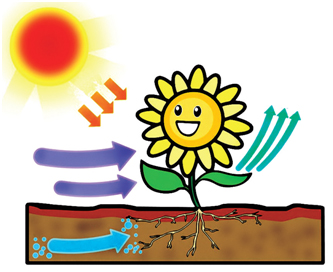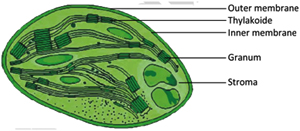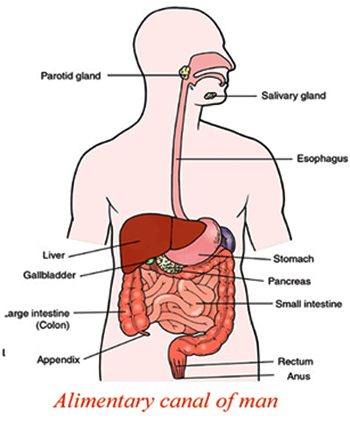1.Nutrition – Food Supplying System
Nutrition – Food Supplying System

Synopsis:
- Procurement of nutrients is known as nutrition.
- Nutrition is of two types.
a) Autotrophic nutrition and
b)Heterotrophic nutrition. - In autotrophic nutrition, organisms make their own food from simple inorganic materials like CO2 and H2O using light as source of energy.
- Heterotrophic nutrition involves intake of complex materials prepared by other organisms.
- Photosynthesis is a process by which green plants containing chlorophyll, produce food substances [glucose & starch] from CO2 and H2O using light as source of energy and release O2 into atmosphere.
- C.B.Van Neil, 1931 proposed and formulated an equation for photosynthesis as

- The balanced equation to show the process of photosynthesis is as follows:

- Photosynthesis is the basic energy source of all living organisms.
- To destarch a leaf, potted plant has to be kept in dark room for 24 hours [it removes the starch already present in the leaf] and boil it in methylated spirit over water bath till it becomes pale white due to removal of chlorophyll.
- If we add Iodine solution to the dechlorified leaf, it turns to blue – black colour indicating the presence of starch.
- There are four essential factors of Photosynthesis viz. carbon dioxide, water, chlorophyll and sunlight.
- In 1648, Von Helmont of Belgium found that water was essential for the increase of plant mass.
- In 1770, Joseph Priestly revealed the essential role of air in the growth of plants.
- Priestly discovered O2 in 1774, but the name oxygen was coined by Lavoisier in the year 1775.
- Priestly experimentally proved that plants restore the air whatever breathing animals and burning candles remove.
- In 1779, Jan Ingenhousz, a Dutch, experimentally proved that in bright sunlight, gas bubbles were formed around the hydrilla plant and it was Oxygen.
- In 1883, Julius Von Sachs found that chlorophyll is present in the chloroplast.
- In 1954, Daniel I.Arnon extracted chloroplast from plant cells, which could carry the photosynthesis.
- The light reactions of occur in grana and dark reactions of photosynthesis occur in stroma of chloroplast.
- The end products of light reaction are O2 ATP & NADPH2 and Glucose is the end product of dark reaction.
- Important events occurring in chloroplast are:
- Conversion of light energy to chemical energy
- Splitting of water molecule
- Reduction of CO2 to carbohydrate
- The form of nutrition differs depending on the availability and type of food as well as how it is obtained by the organism.
- Some organisms break down the food materials outside the body and then absorb it.
E.g. bread mould, mushrooms, yeast, etc. - Some organisms take down the whole material and break it down inside their bodies. E.g.: Mammals
- Some other organisms derive nutrition from plants or animals without killing them.
E.g.: Cuscuta, lice, leeches and tapeworms. - In single celled organisms like amoeba, the food may be taken in by the entire surface but as the complexity of the organism increases, different parts become specialized to perform different functions.
- The process of taking food inside the body is called ingestion.
- The process of breaking complex substances into the simple substances, so that they can be used by the body with the help of the enzymes is called digestion.
- Saliva secreted by three pairs of salivary glands contains an enzyme amylase (ptyalin), which helps in the breakdown of complex carbohydrates to simple ones.
- The alimentary canal is basically a long tube that extends from the mouth to the anus.
- The parts of human digestive system are mouth, buccal cavity, pharynx, oesophagus, stomach, small intestine, large intestine, rectum and anus.
- The digestive system includes the alimentary canal and several associated organs. The functions of system are as follows:
- Ingestion: Taking of food into the body.
- Digestion: Breaking up of complex food substances into simple substances so that they can be used by the body which will be carried out by specific enzymes.
- Absorption: The passage of directed food through the walls of alimentary canal into the circulatory system.
- Defecation: The passage of undigested material from the body through the way of anus.
- Food mixed with saliva passes though the oesophagus by wave like movements called peristaltic movements to the stomach.
- In the stomach food gets churned with gastric juice and HCl.
- Chyme is soft slimy substance in which some proteins and carbohydrates have already broken down.
- The sphincters in the stomach allow only a small quantity of food to pass into the small intestine at a time.
- The small intestine is the longest part of the alimentary canal where complete digestion of carbohydrates, proteins and fats takes place.
- Small intestine receives bile juice from the liver and pancreatic juice from pancreas.
- Bile juice emulsifies the fats, whereas trypsin and lipase of pancreatic juice digests proteins and fats respectively.
- Finger-like projections formed from the walls of intestine are known as villi. They absorb the products of digestion and from villi into the blood vessels and lymph vessels.
- The passage of undigested material from the body through anus is called defecation.
- Indigestion is difficulty in digesting food. It is caused by stomach and duodenal ulcers.
- Our diet should be a balanced one which contains proper amount of carbohydrates, proteins, fats, mineral salts and vitamins.
- Eating of food that does not have one or more than one nutrients in required amount is known as malnutrition.
Malnutrition is of 3 types:- Calorie malnutrition
- Protein malnutrition
- Protein Calorie malnutrition
- Kwashiorkor disease occurs due to protein deficiency.
- Marasmus is a disease caused due to both protein and calorie deficiency.
- Obesity occurs due to overeating and excess of energy intake. Vitamins are micro nutrients required in small quantities. They are water soluble (B complex, Vitamin C) and fat soluble (Vitamin A, D, E and K).
Question and Answers
-
Write differences between Light reaction-Dark reactions, Chlorophyll-Chloroplast.
a. Light reaction – Dark reactionLight Reaction
Dark Reaction
1.It occurs in grana of chloroplast
1. It occurs in the stroma of chloroplast
2.It occurs in presence of light
2. It is not dependent on light
3.End products are NADPH2,ATP and O2
3. End product is Glucose.
4. Photolysis occurs
4. Carbon fixation occurs
5.This is Oxidative Process
5. This is a Reduction reaction
b) Chlorophyll-Chloroplast
Chlorophyll
Chloroplast
1.This is a green pigment
1. This is an organelle, containing chlorophyll.
2.Present in chloroplast
2.Present in palisade tissue of leaves
3.This will trap solar energy
3.This is responsible for photosynthesis
c)Autotrophic Nutrition-Heterotrophic Nutrition
S. No.
Autotrophic Nutrition
Heterotrophic Nutrition
1.
It means that the organism prepares its own food and does not depend on any other organism.
It means that the organism doesn’t prepare its own food and is dependent on other organisms for food.
2.
Food is prepared from CO2, water and sunlight.
Food can’t be prepared from CO2, water and sunlight.
3.
Green plants and certain bacteria have autotrophic mode of nutrition.
All the animals, fungi, most bacteria have heterotrophic mode of nutrition.
d) Ingestion-Digestion:
S. No.
Ingestion
Digestion
1.
Taking in food through mouth is called Ingestion.
Breaking up of complex molecules of food into simple and small molecules is called Digestion.
-
With the help of chemical equation explain the process of photosynthesis in detail?
Ans:
Process of Photosynthesis:-
The chemical equation representing the process of photosynthesis is
6CO2 + 12H2O ? C6H12O6 + 6H2O + 6CO2 - Photosynthesis may be defined as a photochemical reaction, during which carbohydrates are formed from carbon dioxide and water in the chloroplasts of the green plants in presence of sunlight.
- Carbon dioxide, water, light and chlorophyll are essential requirements for photosynthesis.
- Glucose, Oxygen and water are the products of reaction. Oxygen is released into the atmosphere.
- In the process of photosynthesis, the low energy substances like carbon dioxide and water are converted into high energy compounds like Glucose.
-
- Explain the structure of a chloroplast with a neatly labelled sketch ?
Ans:
- In green plants there are special membrane bound organelles called chloroplasts.
- Chloroplasts occur mainly in mesophyll cells of leaves.
- Typical chloroplasts are disc shaped and consist of 3 membranes.
- The third layer that forms stacked sack-like structures is called grana. It is the site for trapping solar energy.
- In the chloroplast there is fluid filled portion called stroma, responsible for enzymatic reactions leading to the synthesis of glucose, which in turn join together to form starch.
- These chloroplasts are green in colour due to a pigment called chlorophyll.
- The chlorophyll and other pigments of chloroplasts are fat soluble and are located in the liquid part of the thylakoid membrane.
- How is the small intestine designed to absorb the digested food, explain?
Ans:- The small intestine is the main region for the absorption of digested food.
- The inner surface of small intestine has millions of tiny finger-like projections called villi.
- Due to the presence of villi, the absorbing surface of small intestine increases.
- The digested food which is absorbed through the walls of small intestine goes into our blood.
-
How are fats digested in our bodies? Where does this process take place?
Ans:
Digestion of fats in our body:- Bile juice secreted by liver emulsifies large fat globules into small fat globules.
- Lipase of pancreatic juice breaks down small fat globules.
- The enzyme present in intestinal juice breaks down fats into fatty acids and glycerol.
- The process of digestion of fats takes place in the small intestine.
- What is malnutrition? Explain some nutrition deficiency diseases.
Ans: Eating food that doesn’t have one or more than one nutrients in required amount is known as malnutrition. Poor health, will full starvation, lack of awareness of nutritional habits, socio-economic factors are all the reasons for malnutrition.
Malnutrition is of 3 types:- Calorie malnutrition.
- Protein malnutrition
- Protein Calorie malnutrition.
- Kwashiorkor Disease: This is due to protein deficiency in the diet. Body parts become swollen due to accumulation of water in the intercellular spaces. Very poor muscle development, swollen legs, fluffy face, difficult to eat, diarrhoea, dry skin are the symptoms of this disease.
- Marasmus: This is due to the deficiency of both proteins and calories. Generally this disease occurs when there is an immediate second pregnancy or repeated child births. Lean and weak, swelling limbs, less developed muscles, dry skin, diarrhoea, etc.; are the symptoms.
- Obesity: This is due to over-eating and excess of energy intake. It is a big health hazard. Obese children when they grow, they will be a target of many diseases like diabetes, cardio- vascular, renal, gall bladder problems.
- What process do you follow in your laboratory to study the presence of starch in leaves?
Ans:- Take a leaf of a plotted plant which has soft, thin leaves.
- Boil the leaf in a methylated spirit over a water bath till it becomes pale white due to removal of chlorophyll. Observe the leaf.
- Spread the leaf in a dish and add few drops of tincture Iodine/ Betadine solution on it.
- Observe the leaf.
- The presence of starch will be indicated by a blue- black colour.
- How would you demonstrate that green plants release oxygen when exposed to light?
Ans:
Aim: To prove that oxygen is produced during photosynthesis by hydrilla funnel experiment.
Apparatus: Beaker with water, test tube, funnel, hydrilla twigs, glowing splinter.
Procedure:- Arrange the apparatus as shown in the fig.
- Place water plant hydrilla in a beaker containing pond water, and cover these by a stemmed funnel.
- Invert a test tube full of water over the stem of the funnel.
- Ensure the level of water in the beaker is above the level of the stem of the inverted funnel.
- Place the apparatus in the sun for at least 3 days.
- After sometime it is observed that gas bubbles come from the hydrilla plant. These bubbles are collected at the end of the test tube by pushing the water into the beaker.
- After sufficient gas is collected the test tube is taken out of the beaker carefully by closing it with the thumb.
Observation: Test the gas in the test-tube by inserting a glowing incense stick which would burst into flames. This shows the presence of Oxygen.
Result: This shows that Oxygen is produced during photosynthesis.
- Draw a neatly labelled diagram of chloroplast found in the leaf, and its role in photosynthesis.

- Draw the label diagram of Human Digestive system? List out the parts where peristalsis takes place.

2 Marks Questions
- Explain the necessary conditions for autotrophic nutrition and what are its by-products?
A.- Autotrophic nutrition takes place through the process of photosynthesis.
- CO2, water, chlorophyll pigment and sunlight are the necessary conditions required for autotrophic nutrition.
-
Carbohydrates and Oxygen are the by-products of photosynthesis.
- Where do plants get each of the raw materials required for photosynthesis?
A.
Raw Materials for Photosynthesis
Source
Carbon dioxide
Atmosphere
Water
Ground Water
Solar energy
Sun
Chlorophyll
Leaf
What will happen to protein digestion as the medium of intestine is gradually rendered alkaline?
A.- The food coming from the stomach to intestine is acidic in nature.
- Bile and pancreatic juices render the internal condition of the intestine gradually to a basic or alkaline one.
- In the alkaline medium, pancreatic enzyme trypsin can act on the food and digest the proteins.
- The enzymes present in the intestinal juice complete the digestion of proteins into amino acids.
- What is the role of roughages in the alimentary track?
A.- Roughages are the fibres of either carbohydrates or proteins.
- They keep a person healthy by keeping the intestine working and moving other food quickly through the alimentary canal.
-
How do non-green plants such as fungi and bacteria obtain nourishment?
A.- Bacteria and fungi are non-green plants. So they can’t prepare their own food materials.
- They are saprophytes which feed on dead and decaying plant and animal bodies.
- The fungi and bacteria break down the complex organic molecules present in dead and decaying matter and convert them into simpler substances outside the body.
- These simpler substances are then absorbed by fungi and bacteria as their food.
- If we keep on increasing the CO2 concentration in air what will be the rate of photosynthesis?
A.- The rate of photosynthesis increases as the CO2 concentration increases.
- Gradually the rate of photosynthesis falls and at a certain CO2 concentration the rate of photosynthesis stays constant.
- Here, arise in CO2 level has no effect on the rate of photosynthesis as the other factors such as light intensity become limited.
- What happens to plant if the rate of respiration becomes more than the rate of photosynthesis?
A.- Respiration is a catabolic process and photosynthesis is an anabolic process.
- In catabolic process, bigger molecules are broken down into smaller molecules like the glucose molecule into Carbon dioxide and water as in respiration.
- In anabolic process like photosynthesis from simple molecules like CO2 and water complex carbohydrates are produced in plants.
- Both constructive and destructive process must occur in a plant for its normal growth.
- If respiration overtakes photosynthesis in a plant, it is starved off from the supply of food and thereby it gets etiolated and finally it leads to the death of the plant.
- If there were no green plants, all life on earth would come to an end! Comment.
A.- Plants play the most important part in the cycle of nature.
- Without plants, there could be no life on the earth.
- Plants are the only organisms that can make their own food and all other living beings directly or indirectly depend on plants for their food.
- Moreover, plants release oxygen into the atmosphere though photosynthesis. Oxygen is essential for the organisms to respire.
- Hence, without green plants all life on the earth would have come to an end.
- Almost all the living world depends on plants for food material. How do you appreciate the process of making food by the green plants?
A.- Among all the living organisms on the earth, only plants are capable of producing their own food and deriving energy from it.
- No other living creature can produce their food and thus depend on plants directly or indirectly.
- Through photosynthesis, plants take energy from the sun, carbon dioxide from the air and water, minerals from the soil. Then they give off water and Oxygen.
- Plants are the primary producers that sustain all other life forms.
- Life without photosynthesis would thus be impossible.
- What food habits are you going to follow after reading this chapter? Why?
A. The food habits I’m going to follow after reading this chapter are:- I will take balanced diet which contains proper amounts of carbohydrates, proteins, fats, vitamins and minerals.
- I’ll avoid taking food containing high proportion of fat.
- I’ll eat food as much required by my body. I’ll not overeat.
- I’ll not eat rich meals over several days.
- I’ll eat simple balanced meals, eat it leisurely and thoroughly masticating the food.
- I’ll avoid doing violent exercise soon after eating food.
- I’ll empty the bowels regularly avoiding constipation.
- I’ll see to have plenty of roughages in the diet.
1 Mark Questions
- Why photosynthesis is considered as the basic energy source for most of the living world?
A. All living things constantly need energy to be alive. They get the energy in the form of food. The food directly or indirectly comes from the green plants through photosynthesis. Hence photosynthesis can be considered as the basic energy source for most of the living world.
- Why is it better to call the dark phase of photosynthesis as a light independent phase?
A. The term dark reaction doesn’t mean that they occur when it is dark at night. It only means that the reactions don’t depend on light. Hence, we call the dark phase of photosynthesis as the light independent phase.
- Why is it necessary to destarch a plant before performing any experiment on photosynthesis?
A. It is necessary to destarch a plant before performing any experiment on photosynthesis because if starch is present it may interfere with the experiment.
- Why is it not possible to demonstrate respiration in green plant kept in sunlight?
A. We can’t demonstrate an experiment of respiration in green plants because if sunlight is present, the CO2 produced in respiration will be used in photosynthesis. So we must conduct an experiment on respiration in green plants in a dark room.
- Name the 3 end products of photosynthesis?
A. Glucose, Oxygen and water are the 3 end products of photosynthesis.
- What is the connecting substance between light reaction and dark reaction?
A. Stroma is the connecting substance between light reaction and dark reaction.
- What is the role of acid in stomach?
A.- HCl found in the stomach helps in killing harmful germs which may have come along with the food.
- HCl creates an acidic medium which facilitates the action of enzyme pepsin.
- Pepsin is active in the presence of HCl.
- What is the function of digestive enzyme?
A.- The function of the digestive enzyme is to increase the process of breaking up of complex molecules into simpler and absorb molecules.
- This makes easy for the body to absorb food.
- What is the role of saliva in the digestion of food?
A.- Saliva is secreted by 3 pairs of salivary glands in the mouth.
- Human saliva contains an enzyme called amylase (ptyalin) that converts starch into maltose (sugar).
- The food is mixed thoroughly with saliva and moved around the mouth while chewing by the muscular tongue.
- Why do you think that carbohydrates are not digested in the stomach?
A.- For the digestion of carbohydrates, enzyme ptyalin or amylase are required.
- The gastric juice produced by stomach does not contain the enzyme ptyalin or amylase. It contains only pepsin which digests proteins.
- Hence carbohydrates are not digested in the stomach.
- They are digested partially in the mouth and completely in small intestine.

















